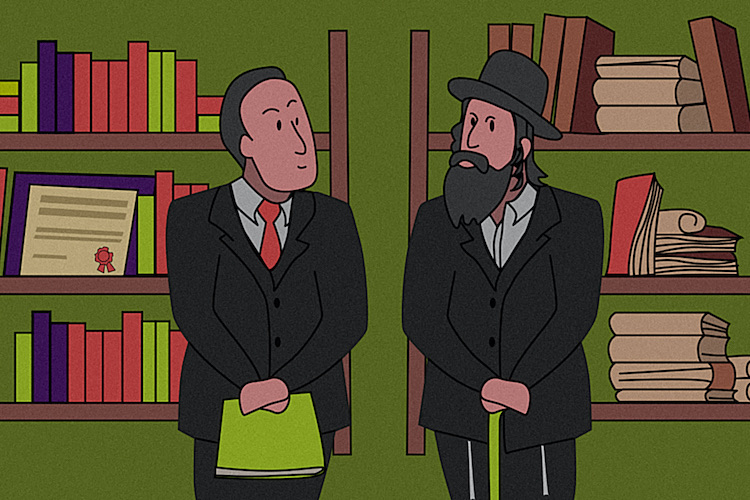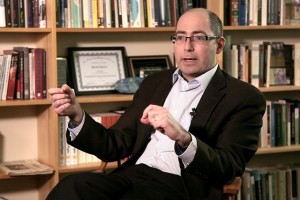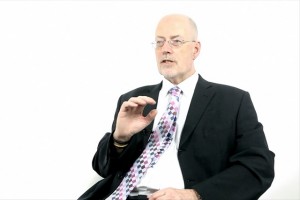Greek and Roman Meteorology
Historian and Philosopher of Science Liba Taub on the relations between myths and science, the ancient attempt...

Hebrew belongs to the family of Northwest Semitic languages, which also includes ancient Ugaritic (died 3,200 years ago) and Aramaic (still spoken in Kurdistan areas, Iran, Iraq, Syria, and the Southern part of the Ex-Soviet Union). And, including Arabic, these languages belong to the largest subfamily of Semitic languages, namely Central Semitic. The Semitic language family is a part of Hamito-Semitic or Afro-Asiatic. Hamitic languages are those spoken in Africa and Northern Africa, like Cushitic languages in Ethiopia, Berberic languages in Algeria and Morocco, Chadic languages in Chad, and ancient Egyptian. We cannot actually get, although there have been some attempts, to construct Proto-Hamito-Semitic; that’s why some scholars prefer to call them Afro-Asiatic.
Many people think that Hebrew had been recovered. I rather call it the “emergence of spoken Hebrew”. Hebrew was not revived, because it never died. Let’s start from the beginning. It was spoken at the time of the Hebrew Bible. And it was recorded as a language of the Mishnah, which is a part of the Jewish Talmud. Since about 200 CE, Hebrew has been used mainly in writing. Still, it was spoken as a lingua franca of Jews.

There are data even from as early as the late 15th century by Arnold von Harff, a German traveler who recorded some sentences useful for a traveler in Jerusalem to the extent of elementary sentences which we use in our everyday life. He even had a sentence in Hebrew that says, “Lady, I want to sleep with you tonight”. I do not know if a prostitute in the XV century spoke Hebrew in Jerusalem, but probably not. So, we do have data on spoken Hebrew, something like a pidgin or a lingua franca. Hebrew was not even dead as the spoken medium.
Amazingly enough, we even have written letters from Jews to Napoleon. Very intense Hebrew literature, both religious and secular, existed for almost two millennia. It was not a mother tongue; of course, nobody was born into Hebrew, but people learned Hebrew. So, when they came to Israel (or Palestine) to see Jerusalem and the Holy Land, they would be able to communicate with other Jews. One author of the early 19th century attested that he heard Jews speaking to their “coreligionnaires”, people from all over the world who shared the same religion — and language. How else would they be able to speak?
At the beginning of the 20th century in Palestine, during the second Aliyah (immigration wave), Hebrew started to be actively used. In my view, spoken Hebrew re-emerged first, very much like Creole languages, because it started with the children. In the 1950s, we had a humorist named Ephraim Kishon who wrote, “This is the only country in the world where mothers learn their mother tongue from their children”. This is very similar to what happens with Creoles.
They did not have only Biblical Hebrew; there were all kinds of Hebrew from all periods when Hebrew had been written before. When we talk about creolization, we talk about colonization and the impact of the target language. The children came with the grammar of their parents, and probably there were also some cognitive universals. But in the case of Hebrew, it was not a colonization process; rather, it was idealism which brought school education with it.
Why was it, not Yiddish that was revived? The idealistic movement of Zionism was to speak Hebrew and not Yiddish. And we have records that many Palestinian Arabs learned Yiddish to communicate with new coming Jews who moved there at the beginning of the 20th century. But idealism enforced Hebrew. So, there were many-many teachers in quite a few locations widespread in Palestine during the last decade of the 19th century going well into the 20th century who taught Hebrew. But the Hebrew they taught was not the Biblical Hebrew; it was a reconstructed Hebrew. They had written grammar and good teachers who mastered only written Hebrew, but they taught children. The children started speaking Hebrew in class between them, then they went out during recess and spoke Hebrew outside of the class among themselves, and then they brought it home and actually forced their parents to speak Hebrew because it was an easier language for them and it could encompass more than the language they initially spoke. But at that time, there was also Hebrew Language Committee, now it is called The Academy of the Hebrew Language, and they invented words that Hebrew did not have for daily life. So, they taught it to children. Of course, unlike Creole languages, they also had a written tradition (Biblical Hebrew and the 18th-20th centuries literature). There are two parallel lines of development: written and spoken, which, of course, influence each other. This is how today’s Hebrew started.
The question of the differences between Modern and Ancient Hebrew is a bit difficult because if you ask any literate person who has Hebrew as his mother tongue, he would say that it’s the same language. But if you ask a Semitic scholar who mastered the Biblical language, he will not be able to read any modern Hebrew writing today. So, the language is actually very-very different. Why do Israelis feel it’s the same language? Because they also start to learn the Bible from the age of seven. But, generally, in linguistic terms, they are different, although both are Semitic and, essentially, Hebrew.
If we talk about the Semitic writing system, at the very beginning, in Sinai in the second millennium BC and much later, all script was written letter-by-letter with no spaces between them. In Modern Hebrew, all prepositions are still attached to words. The writing system of Hebrew does not allow separate usage of a single consonant. For instance, the Hebrew preposition “mi-“(-מ, from) originates from “min-” (-מן, from), which has two consonants. And the latter one, therefore, was written separately. So, if we would like to express “he came out from the house”, we would write “min habait”. But if we use a shorter preposition (which means the same), we will have them written together. Therefore, it’s only a matter of the writing system.
In terms of syntax, most, if not all, Semitic languages today are influenced by other languages. Even Akkadian, the most ancient among recorded Semitic languages, had been strongly influenced by Sumerian because the Semitic branch of the tribes went to Mesopotamia (today’s Iraq) and met with the people who had already been living there and spoke Sumerian, not a Semitic language. So, if we talk about Proto-Semitic, it is a verb-initial language, and the syntax is VSO (Verb-Subject-Object). Then it changed to SOV (Subject-Object-Verb) in Akkadian. The same happened to Ethiopian languages; they changed their word order to SOV (Subject-Object-Verb), because of the non-Semitic Cushitic languages that are the substrata of these languages. Hebrew today is SVO (Subject-Verb-Object), mostly due to European influence. So, all languages are influenced by the environment regardless of whether they belong to the same family or not.
Written language is never actually much like spoken language, so the newly emerged Hebrew is very different in phonology; it has changed a lot. Having emerged mainly from people who came from Europe, Hebrew has a lot of Indo-European influences both in the lexicon, phraseology, and syntax. But the morphology is about the same as in Ancient Hebrew and other Semitic languages. Antoine Meillet, a French scholar at the beginning of the 20th century, said that morphology is the last hold of a language. If morphology changes, it is not the same language anymore. Morphological change is practically minor in Modern Hebrew.

The majority of people who wanted to start speaking Hebrew in the late 19th century and the beginning of the 20th century were newcomers with Slavic backgrounds (who had Russian, Ukrainian, or Yiddish as their mother tongues). And it influenced Hebrew. For example, similarly to Russian, there is no need for a verb in the sentence as a predicate. There are many languages like that. Hebrew never needed a verb to have as a predicate to construct a clause. It was very lucky for spoken Hebrew to emerge like this because have it has been not this way, we may have needed a verb. But the point is that the people who revived Hebrew had Slavic languages as their mother tongues, and this helped conserve this type of clause. For instance, “yikhtov” (יכתוב), the y- at the beginning is the subject, the third singular masculine, and “-ikhtov” stands for ‘write’. So, it’s ‘he will write’. Therefore, a verb in Hebrew is not a predicate, it’s both a subject and a predicate, and it’s a full clause.

The morphology is very interesting because it’s nonconcatenative. Hebrew words rely on roots, or a sequence of radicals, typically consisting of three consonants. The very first dictionaries were based on roots, not alphabetical order, as we are acquainted with dictionaries today. (This is still very common with dictionaries of Arabic.) The roots enforce themselves into pre-existing patterns. For example, to say “katav” (כתב, he wrote), we take the root k.t.v. and integrate it into the pattern of the past tense “-a-a-“. That’s how most Semitic words are constructed. You cannot pronounce the pattern as well as the root. This is a feature of all Semitic languages, including, to some extent, even Eastern Aramaic languages that had changed radically from the structure of Hebrew, Arabic, and Ancient Aramaic. They have linear morphology, but still, they have remnants of this type of integrating root into patterns.
I had the following exercise for my students: I suggested that they take a word like “pe” (פּה), which stands for “mouth”; it includes one consonant and one vowel. What do they do if they want to turn this noun, “pe”, into some kind of a verb like “I used my mouth”? So, they have a pre-designed pattern like “-i-e-” and they have to integrate a root into it. There are three slots in the pattern; how do they do it if we have just a single consonant in the root? But there are ways of doing it, and they are automatic, for example, “piyiti”, adding a semi-vowel, and adapting the original vowel to fit the common inflection. It’s very easy for a Hebrew speaker or any other Semitic speaker to do these things. This is how the lexicon gets enlarged by new derivations.
This system of verbal derivation is called “binyanim” (בניינים).
The notion of binyanim was introduced by Medieval grammarians. The most common binyan or way of producing new verbs in today’s Hebrew is “piel” (פעל); this is exactly what I have just described with the way a verb can be derived from the noun pe ‘mouth’. A common example is to take roots like “k.t.v”, which basically means ‘write’, insert “-i-e-” in it, and produce “kitev” ‘write a copy and send it to a third party’. But there are other patterns. To some of the patterns, we can add consonantal augments, and change vowels, in Ancient Hebrew, it was also the doubling of the radical (which does not exist anymore in Modern Hebrew). If we add “sh-” (-ש) at the beginning, it’s like “re-,” and we get “shikhtev” (שכתב, rewrote). “khazar” is ‘return’ (חזר, -a-a-) and then we can say “shikhzer” (שחזר, return again). So we can add consonants and other augments or change the patterns to get a new derivation. In this way, we can also change the voice and make something passive. We can say “shikhtev” and “shuhtav” meaning “something rewritten”, “-u-a-” is a pattern for the passive voice. Or we can add “h-” (glottal fricative) for causative. These patterns are very productive; people use them automatically.
We can do that for both verbs and nouns. We do not call it binyanim for nouns, we rather call it mishkalim, but it’s the same. It’s a pattern primarily with vowels but also with some consonants. For instance, in “merkava” (מרכּבה, chariot) the root is r.k.v., then we add a pattern with “m-e-a” and feminine morpheme “-a” at the end and derive a new noun. Or, consider “darakh” (דרך, step). You can derive “midrakha” meaning “the place you step on” or, in fact, “sidewalk”. The majority of content words had been constructed this way (with roots and patterns), and function words – not usually.
These patterns are pretty much regular. For instance, if we add a morpheme, “-ut” at the end of a noun, then we can say pretty confidently that it’s an abstract noun. For example, “melekh” (מלך) is a king and “malkhut” (מלכוּת) is a kingship. But it’s not always like that. At school, people learn the pattern “-a-e-e-t” with “t” (for feminine) at the end, which stands for diseases (e.g., “tsahevet”, yellow fever). But there are so many nouns like that that do not denote diseases; for instance, “rakevet” (רכבת) is “train”. In verbs, “h-” binyan usually means causative, but there are some verbs with “h-” which do not mean that. So, it’s not always predictable. Some patterns for localities, diseases, and tools are productive. In general, I cannot say that we have a system with exceptions or irregularities; we just have patterns, although some regularities are there and are productive.
In terms of neologisms, we do not invent new roots; we rather borrow them from other languages. Take, for example, the English “neutral”. We first extract the consonantal root from it, so we get n.t.r.l, then we apply pre-designed patterns. And if I want to say, “I neutralized someone”, I insert the corresponding pattern into the root and get “nitralti” (ניטרלתי, I neutralized) or “nitrel” (ניטרל, he neutralized).
Currently, I work on spoken languages; I was a part of the team compiling a dataset for spoken, spontaneous, conversational Hebrew. What can Hebrew contribute to general linguistic knowledge? Aristotle was a philosopher, who was very interested in languages, but because of the interpreters of Aristotle, we were hooked on his description of the sentential structure, which must include a Subject and Predicate.
But if you go to languages themselves, you will see that you do not need a subject and you must get rid of zeros. In 1953 Wittgenstein, in his philosophical works, described an artificial language, a designed language. There is a builder and his assistant. The builder needs only four items to build: blocks, pillars, slabs, and beams. And he would say “slab”, and the assistant will bring it to him. Wittgenstein notes that if you do not utter the utterance “Please give me …”, you actually do not need it. You say only “slab”. Therefore, he asks: are these sentences elliptic? This is my idea, and I learned it not from Wittgenstein; I learned it from Hebrew because the corpus of spoken Hebrew tells me that you do not really need a subject. Of course, not in a context. But a language is always embedded in some type of context in linguistic discourse. You add a subject only if you need it. In the majority of clauses, sentences do not include a verb. Hebrew is constrained to include subjects only in verbs, but this is a constraint of morphology. Moreover, there are verbs whose subjects do not refer to anything in the outer world. For instance, if something is in the passive, but you do not really say it in the passive voice. For example, in “lakkhu” (לקחו, they took) “u” is not the agent; it’s a formal subject that has a non-agentive entity in semantics. There are many things like that. A common verb like “haya” (היה, he was), for example, which has by morphological constraints an embedded subject in it, is found in sentences with what seems like feminine or plural subjects so that the subject within the verb cannot be semantic. Taking everything into consideration, there are so many sentences or clauses without subjects and verbs. Then you can learn something from Hebrew about language in general.
Edited by Ekaterina Vylomova

Historian and Philosopher of Science Liba Taub on the relations between myths and science, the ancient attempt...

Physicist David Kaiser on measuring time delay, problems of communications during war, and governments impact ...

University of Warwick Prof. Mark Harrison on military-industrial complex, Stalin's Great Breakthrough, and pap...